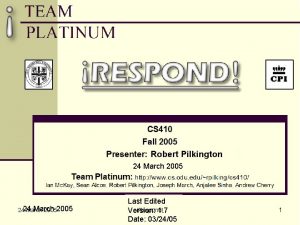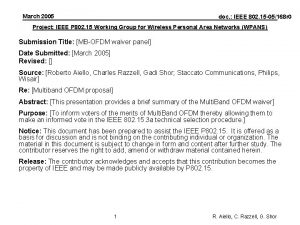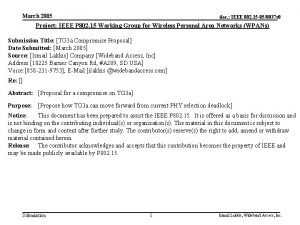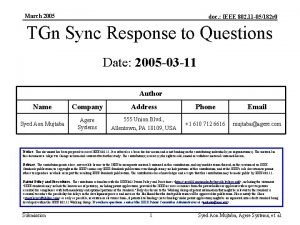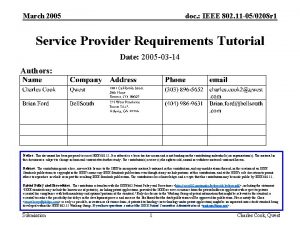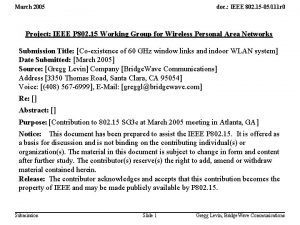March 2005 doc IEEE 802 19 050009 r











- Slides: 11

March 2005 doc. : IEEE 802. 19 -05/0009 r 0 U. S. BPL Regulatory Status Date: 2005 -03 -17 Authors: Notice: This document has been prepared to assist IEEE 802. 19. It is offered as a basis for discussion and is not binding on the contributing individual(s) or organization(s). The material in this document is subject to change in form and content after further study. The contributor(s) reserve(s) the right to add, amend or withdraw material contained herein. Release: The contributor grants a free, irrevocable license to the IEEE to incorporate material contained in this contribution, and any modifications thereof, in the creation of an IEEE Standards publication; to copyright in the IEEE’s name any IEEE Standards publication even though it may include portions of this contribution; and at the IEEE’s sole discretion to permit others to reproduce in whole or in part the resulting IEEE Standards publication. The contributor also acknowledges and accepts that this contribution may be made public by IEEE 802. 19. Patent Policy and Procedures: The contributor is familiar with the IEEE 802 Patent Policy and Procedures <http: // ieee 802. org/guides/bylaws/sb-bylaws. pdf>, including the statement "IEEE standards may include the known use of patent(s), including patent applications, provided the IEEE receives assurance from the patent holder or applicant with respect to patents essential for compliance with both mandatory and optional portions of the standard. " Early disclosure to the TAG of patent information that might be relevant to the standard is essential to reduce the possibility for delays in the development process and increase the likelihood that the draft publication will be approved for publication. Please notify the Chair <shellhammer@ieee. org> as early as possible, in written or electronic form, if patented technology (or technology under patent application) might be incorporated into a draft standard being developed within the IEEE 802. 19 TAG. If you have questions, contact the IEEE Patent Committee Administrator at <patcom@ieee. org>. Submission 1 Barry O'Mahony, Intel Corporation

March 2005 doc. : IEEE 802. 19 -05/0009 r 0 Agenda • Old FCC rules applicable to BPL • New FCC rules for BPL • Summary Submission 2 Barry O'Mahony, Intel Corporation

March 2005 doc. : IEEE 802. 19 -05/0009 r 0 Old FCC Rules • Broadband Over Powerline (BPL) systems operate under Part 15 on an unlicensed basis. • As with any Part 15 system, BPL may interfere with licensed systems only to the extent that the interference does not rise to the level of “harmful interference” – FCC definition of harmful interference is “Any emission, radiation or induction that endangers the functioning of a radio navigation service or of other safety services or seriously degrades, obstructs or repeatedly interrupts a radiocommunications service operating in accordance with this Chapter” [i. e. , FCC Rules 47 C. F. R. ] • Prior to October 2004, operated under rules for Carrier Current Devices – 15. 3(f): “A system, or part of a system, that transmits radio frequency energy by conduction over the electric power lines” Submission 3 Barry O'Mahony, Intel Corporation

March 2005 doc. : IEEE 802. 19 -05/0009 r 0 Carrier Current System Rules • Conducted Limits – Part 15. 107(c) – 1000 u. V in the band 535 -1705 KHz • Radiated Limits – – – Submission Part 15. 109(e) 9 KHz – 30 MHz: same as for intentional radiators Above 30 MHz: same as for other unintentional radiators Measured at 3 “typical” installations At each installation, measurements taken on at least 16 radials around the equipment 4 Barry O'Mahony, Intel Corporation

March 2005 doc. : IEEE 802. 19 -05/0009 r 0 Carrier Current System – Issues • Measurement Procedures ambiguous – How to apply to distributed BPL systems? • Suspicion that measurements at radials around a point do not accurately evaluate radiated emissions – Since equipment in question is connected to a large-scale wireline network • Instances of interference reported – Interference asserted to be “harmful” • Regulatory uncertainty believed to be inhibiting deployment of BPL Submission 5 Barry O'Mahony, Intel Corporation

March 2005 doc. : IEEE 802. 19 -05/0009 r 0 Revision of FCC rules for BPL • May 2003 Notice of Inquiry (NOI) proposes new category of “Access BPL”, specifically for BPL systems • March 2004 Notice of Proposed Rule Making (NPRM) • April 2004 release of NTIA Report on BPL – Analyzes potential effects of BPL on Federal wireless systems – Analyzes 10 million measurements made on BPL systems, and extensive analytical modeling • October 2004 Report and Order (R&O) adopts new rules – Access BPL allowed in 1. 705 – 80 MHz band – Incorporates many recommendations in NTIA Report – Also defines “In house BPL” Submission 6 Barry O'Mahony, Intel Corporation

March 2005 doc. : IEEE 802. 19 -05/0009 r 0 New FCC Rules – Salient Points • “Access BPL”: A carrier current system installed and operated on an electric utility service as an unintentional radiator that sends radio frequency energy on frequencies between 1. 705 MHz and 80 MHz over medium voltage lines or over low voltage lines to provide broadband communications and is located on the supply side of the utility service’s points of interconnection with customer premises • New Subpart (Subpart G) of Part 15 • Principal change is in measurement guidelines, rather than limit levels Submission 7 Barry O'Mahony, Intel Corporation

March 2005 doc. : IEEE 802. 19 -05/0009 r 0 New Access BPL Rules (2) • Radiated limits for Access BPL – Medium Voltage (1 KV-40 KV) distribution lines • Limits unchanged from old Carrier Current rules – Low Voltage (120 V/240 V) drop lines • Limits below 30 MHz relaxed to match those of other unintentional radiators • Must include ability to remotely control frequency and power levels, and shut down individual components – Including ability to notch frequencies 20 d. B ( <30 MHz) or 10 d. B (>30 MHz) below applicable Part 15 levels • Must register in publicly available database • Must consult with local public safety users • Must comply with exclusion bands and exclusion zones Submission 8 Barry O'Mahony, Intel Corporation

March 2005 doc. : IEEE 802. 19 -05/0009 r 0 New Access BPL Rules (3) • Exclusion bands for Aeronautical stations and aircraft receivers – Applies to overhead medium voltage installations – No operation on 2. 85 -3. 025, 3. 4 -3. 5, 4. 65 -4. 7, 5. 45 -5. 68, 6. 525 -6. 685, 8. 815 -8. 965, 10. 005 -10. 1, 11. 275 -11. 4, 13. 26 -13. 36, 17. 9 -17. 97, 21. 924 -22, 74. 875. 2 MHz • Exclusion zones – – Applies to overhead medium voltage installations Within 1 Km of coast stations Within 29 Km of VLBA radio astronomy installation Certain additional frequencies excluded in these regions • Consultation Areas – Access BPL operators required to consult with certain aeronautical and other Federal entities in certain geographic areas Submission 9 Barry O'Mahony, Intel Corporation

March 2005 doc. : IEEE 802. 19 -05/0009 r 0 New measurement guidelines • Antenna height 1 m for <30 MHz, varied 1 -4 m to maximize emissions for >30 MHz • Tested as a complete system, with all couplers, injectors, etc. , installed • Overhead MV lines – – 10 m horizontal separation distance Slant range distance used when applying distance correction factors Measured at 0, ¼, ½, ¾, and 1 wavelength along line from injection point Repeated for each Access BPL system component • Underground MV lines – Measured at 16 radials around pad-mounted transformer – Essentially unchanged from old Rules Submission 10 Barry O'Mahony, Intel Corporation

March 2005 doc. : IEEE 802. 19 -05/0009 r 0 Summary • October 2004 FCC R&O adds Subpart G to Part 15, addressing Access BPL and In-house BPL systems • New Measurement Guidelines for overhead MV lines adopted – Intended to ensure that potential distributed radiation from overhead lines is accurately measured. – Emission limits themselves unchanged; – But more realistic measurement scenarios will result in lower injected power in order to meet these limits Submission 11 Barry O'Mahony, Intel Corporation












